Through The Eyes Of The Seneye Reef Monitor
The Seneye is a line of monitors designed to make your life much easier. They come in various models to accommodate most types of aquariums and even your pond! The product that is up for review today is the Seneye Reef Monitor made by Reef Radiance. Before I open the package I will first explain what exactly this is supposed to do. THIS IS NOT AN AQUARIUM CONTROLLER! It cannot flip on switches, pumps, react to certain parameters, or anything a controller can do. These are not in the same category and should not be compared to anything more than an aquarium monitor, just to clear up any confusion. Mine was shipped straight to my door with bubble wrap packaging and fragile stickers all over so you can be ensured yours will also arrive safely. The next section is all the information taken directly from the package short of the bar code.
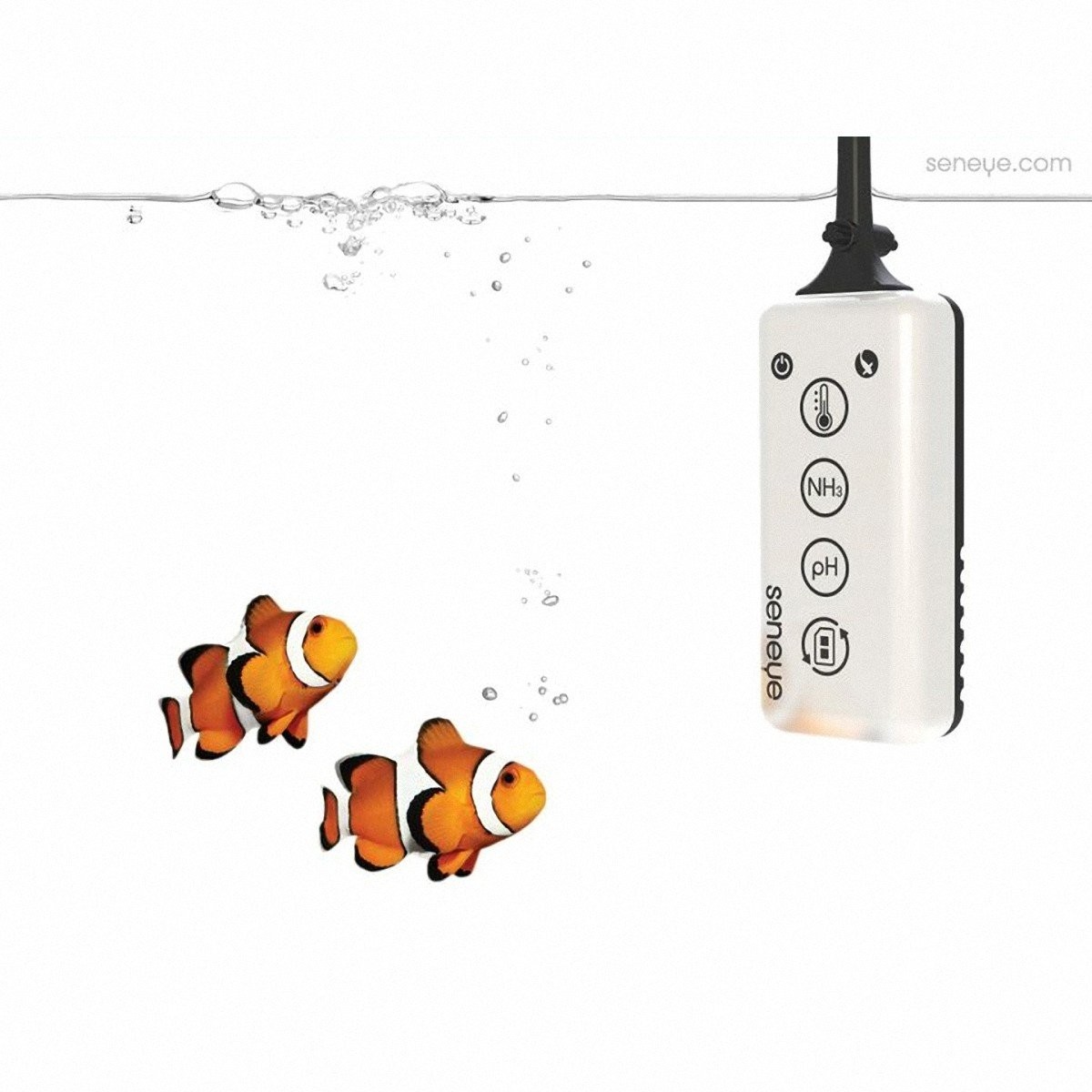
ADVERTISED FUNCTION:
The Seneye monitors Temperature (C&F), Water Level, NH3 (with Seneye+ slide), pH (with Seneye+ Slide), Light spectrum, PAR, LUX, and Kelvin. The Seneye+ slide can take 1500 NH3 readings, 1500 pH readings, the slide lasts for a whole month, and it even graphs the readings it does take.
The Seneye has a fairly wide range:
- pH: 6.50-9.00
- NH3: 0ppm-.5ppm
- Temperature: 1-40 degrees Celsius
- Kelvin: 2000K-20,000K
- LUX 0-150,000
- PAR 0-2,000
INCLUDED PIECES
- Seneye Reef Device
- Seneye+ slide (one month)
- 1 Suction Cup
- Quick Start Guide
REQUIREMENTS
- Windows PC with internet access
- Windows XP, Vista 32/64-bit
- Windows 7 32/64 bit
- Full size USB port
- Minimum 1Ghz processor and 128mb RAM
- HTML5 Internet Browser
- Requires Free Download of Seneye Connect Application @ www.seneye.com/downloads
- (For other operating systems check out www.seneye.com
WHY SENEYE? (Manufacturers Message on the Package)
“Seneye connects your aquarium to the internet and sends you alerts if something goes bad. View your aquarium’s parameters from anywhere in the world on your own webpage. Find out more at www.seneye.com or email us on [email protected].”
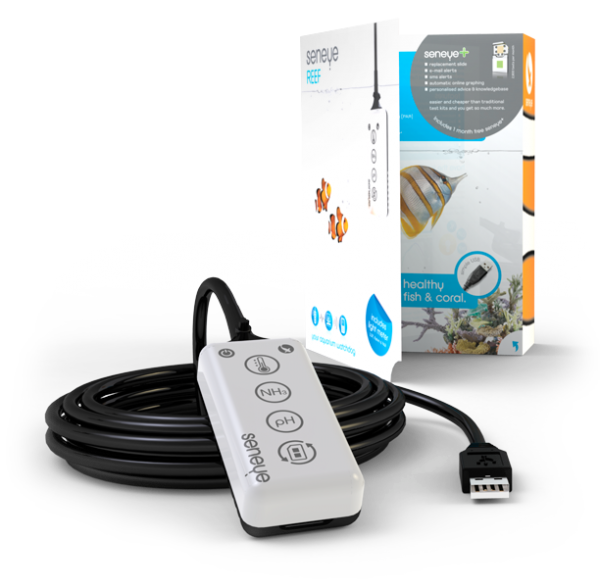
INITIAL FEELING:
I have not yet opened the box. All of this information is displayed right on the package, which is pretty cool. At this point I am quite excited to open the package. All of the features seem useful. Knowing what my light levels are will really help me decide if my tank could use an upgrade. This product does not come with anything I would not want, which is very important. I play guitar and often receive products that have more functions than even the most oddball of musicians would want. This apparently does not have that problem. One issue I have, which may or may not be the companies fault, is that there was no advertisement for Mac users. Apple is not as popular as Windows and I do have a couple Windows laptops. This unit is Mac compatible, but only with a 3rd party app. Most Mac users have gotten used to this, so it may not be an issue to all of us Apple-Heads. Other than that, this unit seems very promising and I cannot wait to open the box!
TIME TO OPEN!
The Package itself is a cardboard box not unlike that of a computer game. The Seneye Reef is packaged inside the box in a plastic case that seems to protect it well. It was also very easy to open, unlike some plastic packages that are melted shut and require scissors or dangerous blade. I feel this is important, especially with aquarium use. An open wound will sting when submerged and possibly lead to infection. The pieces are all neatly organized, so there wont be any jumbling around in the box. All in all, the product was shipped and packaged well. The unit would be easy to take out of the box at a store to get a closer look before you buy it. No complicated puzzle of boxes to try to cram back into the package or loose pieces. It is all right there ready to view.
They thoughtfully inserted a Quick Guide right on top of everything so it is hard to miss. Included on the guide are six easy steps.
- Register and Install Software @ www.seneye.me
- Soak Slide for at least 24 hrs, 48 hrs if it is for saltwater (I will be soaking for 48 hrs).
- Download Full User Guide @ www.seneye.me/seneye-userguide.pdf
- Connect Seneye To PC (With Seneye Connect Running)
- Leave for 1 Hour to update and sync personal settings
- Install the Soaked Slide (enable your Seneye+ using the Code on the slide packaging
Looks like I have some steps to take before “testing the waters.” In the meantime, I am going to inspect the unit itself. It has a very long USB cable that is connected to the top of the unit. The monitor itself is white and black and has a very easy to read face. Ironically, it could almost pass as an Apple product. The suction cup fits nice and snug on the unit. The back of the unit looks like an MP3 player with an interestingly shaped camera lens. The place to insert the slide is on the back and easily accessible. The slide comes in a handy dandy freshness pack that looks relatively easy to open, unlike the standard sauce packs at your local fast food joint. All in all, this looks extremely user friendly and is not too large, which minimizes equipment in your display tank or sump. I still have a good feeling about the Seneye Reef at this point.
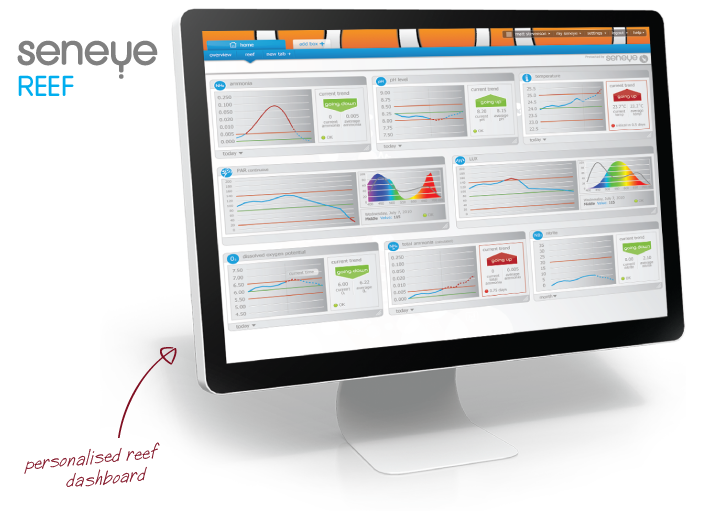
PREPARATION PROCESS EXPERIENCE:
STEP 1: REGISTER AND INSTALL SOFTWARE
The initial page is extremely easy to navigate! The main portion shows you a few tips for smooth operation. It reminds you to update your browser to one that accepts HTML5, informs you to use the same email for all Seneye Products, and reminds you to download the full user guide. The registration is in a small portion on the right hand side of the page and is quite obvious. You have to be blind to miss it.
Once you type your email it takes you to the Aquarium Setup page. It has an option to click for pond or aquarium. It asks you to fill out a form of the included information: description, age, type, make, model, volume in Liters. The information you are required to fill out is in Metric, so you will need to have the conversions handy if you are not familiar with centimeters or liters. Luckily, Google has a quick converter for pretty much any need. Once I got the metric conversions the form was easy to fill out.
Now onto the next step, Profile Details. This allows you to upload a profile picture of your aquarium for a personalized feel you get from social website like Reef2Reef. Uploading the picture was easy. I simply uploaded it from my phone via USB with no issues. The last step is to confirm your details; Name, gender, user name, location, and password. Fill that out and Step 1 is complete. Don’t forget your password! From there you are redirected to a page that thanks you, gives you a link to buy the product in case you have not, and even has tabs for the user guide, dashboard guide, and downloads! The software download and installation was fast and painless.
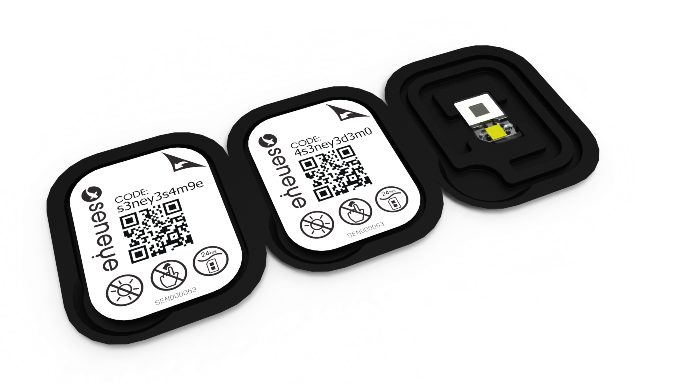
STEP 2: SOAK THE SLIDE
This seems easy, however it does not specify what to soak the slide in or any real specifics other than the time frame of which to soak. 48 hours is the required soak time for saltwater. I will have to check online before I can be certain on the method for which this should be done. Thankfully, the user guide is easily accessible from the web page that is still up. With a quick scan I learned that you simply leave the slide in a glass of tank (or pond) water for two days. I will be soaking mine in a small sterilized food container at room temperature in my stand. Let’s hope I don’t forget about it! By the way, the slide is roughly the size of a SIM card. I am very curious to see how these work. This step will last for 48 hours.
STEP 3: DOWNLOAD THE USER GUIDE
Click. Opened! You can also right click and download it as a PDF. It has a brief description of the product and a table of contents for quick reference, but reading it fully during the two day waiting period is a must. There is a great diagram of all the parts and icons on the unit, which you will need to know. The whole manual is self explanatory and very easy to read. I am a fan of getting to the point. It even warns you that your anti-virus program may not allow the program to install which is normal with most 3rd party software. The slide installation guide is illustrated so you cannot mess this up. There are 3 ways to use this monitor. For constant monitoring you can hook it straight into your PC or any type of wireless USB sender. If you want to periodically monitor the Seneye you can hook it up to the Power Supply which is not included. The rest of the manual is very informative of what I am going to experience later on.
STEP 4: CONNECT SENEYE TO PC
Open the program and plug in the monitor to your USB port. It doesn’t get easier than that! When you plug it in the unit flashes like a Christmas tree! The driver automatically installs and it seems to be ready to go. It even asks you to give your device a name, which really comes in handy if you have multiple water sources to monitor. The unit configures itself, but does require an hour or less to do so. Turn off your power saving settings during this period to ensure it is not interrupted. Mine took less time than it took to write this paragraph, so it will vary based on your computer’s performance. As quick as that was I am still 2 days away from using this. The slide must be fully soaked or I cannot get the full functionality. In the mean time I will sit back and enjoy my tank before the Seneye tells me just how good or bad my system really is. The anticipation is building greatly.
IN THE MEANTIME:
During the waiting period I tinkered with the software and played with the light meter in my kitchen. My PAR level at the dinner table is .2 and my LUX is at 8.3. It is not registering a specific Kelvin at this point, probably because I am measuring a 16 watt bulb from 9 feet away. I am not near any light greater than that so at this point I am going to dive into the program and see what the usability is like and possibly prepare for anything at all that may be needed or purchased.
There are accessories for the Seneye that are not included with the unit. They have an optional float that the monitor can rest on to measure light directly beneath your fixture rather than holding it with your hand. There is also an optional power supply for those with no computer near the tank, though it omits constant monitoring from the equation. For those who want to hook it up to a computer in another part of the room or for pond use there is a heavy duty extension cable. Last is using a wireless usb sender, which allows up to 4 units to be plugged into and sent cable free to your wireless router, but there is no specific wireless accessories made by Reef Radiance. Being USB, there are a great deal of ways to be wireless, so the fact that a computer is required is not as bad as it sounds. Each accessory has its uses and makes total sense. The program has hints of future hardware upgrades, which has me on the edge of my seat. It already does quite a bit for being such a small piece of equipment.

optional float that the monitor can rest on
There is also a Settings tab on the program, but requires logging onto the website to change the appropriate ranges and to switch between C&F. On the Dashboard online it is very easy to change settings of every reading! It will automatically sync to the device after 30 minutes unless you manually re-sync it through the actual program. I quickly changed each parameter range to suit my needs and opted to let it sync itself. It did just as it described! You can tell it syncs when the red light comes on in the Sen”Eyeball” that stares at you as you tinker with the software. The Dashboard online has customizable widgets for those of you who do not want to see the news feed or if you omitted certain features, allowing for easy to read and useful data. At this point I have done about all I can but wait for the slide to soak.
During my two day waiting period, I located the Seneye application for my iPhone. They had two available versions. The free version is pretty basic. It allows for quick access to your readings anywhere you have internet capabilities! The paid version has a few more features. You can view multiple units and the app is a little more interactive. This is still very new, so there have not been any ratings on the App Store just yet. Both supply real-time readings that are updated each time the unit refreshes itself. The slide is almost ready for action! Currently there are only two more hours left to soak in the cup of water. The anticipation is building greatly!
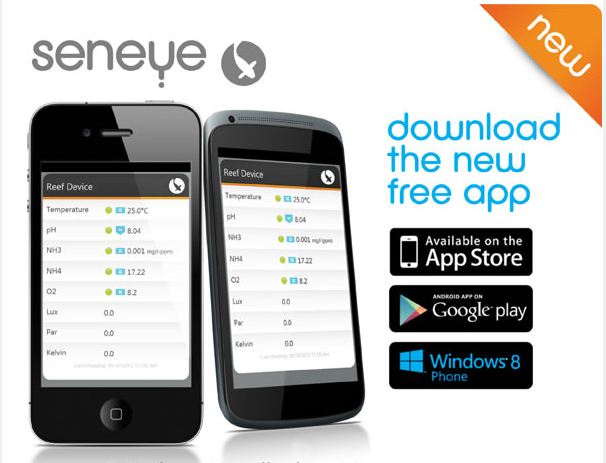
seneye app
STEP 5: REGISTER THE SLIDE
This was a really easy thing to do. The slide has a very legible code on its package that you simply type into the software to activate. The slide is now ready to be installed into the unit and start taking measurements. The software even has a handy timer to inform you of the remaining life left in your slide and displays the code so you know which slide you used. I like labels, so that is awesome.
STEP 6: INSTALLING THE SLIDE
Ease of access is very important to me. If it is a pain in the wrasse to change batteries in something I really get frustrated at the engineer who designed the particular item. The back cover popped off easier than I expected! It simply pulls right off. No screws, tabs, or painful prying with your fingernails to get in the way of replacing the slide. Since the slide is shaped like a SIM card there is no way to mess up when putting in its 5 sided slot. That prevents inserting them upside down or backwards, which would certainly foul the readings. It informs you to install the slide under water to ensure no air can be trapped in the device, which can mess the slide up as well. Plop the cover back on and stick the unit onto the inside of your tank where you can see it. Now comes the part where it may be of difficulty to some.
STEP 7: PLACING YOUR SENEYE DEVICE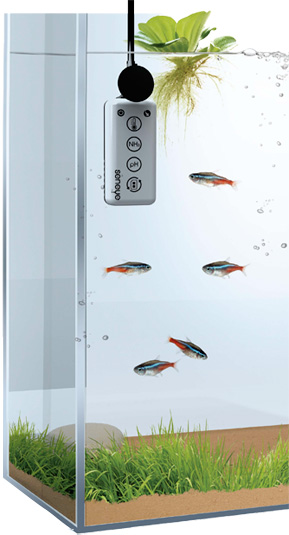
If you spent the extra bucks on the USB sender or an extension cable then this may not be as difficult to plan. The cable on the device itself is a good length, however it requires a computer or power supply for its full function. Putting your computer near your reef tank may not be possible. Some tanks are in-wall and putting a random computer near it may not be ideal, especially if it took years to convince your significant other to let you cut a hole in the wall. My reef is limited to the fish room, so I have plenty of space at my disposal. The laptop will sit right next to the tank on a shelf until I decide to get a wireless USB sender. This requires a drip loop and the cable even has a drip stopper that prevents water from creeping up into your electronics. Safety first! Thanks for looking out. The Seneye does not have to sit in your display tank. As a matter of fact you only need it in there if you need constant light monitoring. Once you know your levels you can place the unit out of view in the sump where it will still read the same water. That is a plus. The powerheads and scraper already take up space that could be used for corals. I will be using it in the sump after my lights get tested. They sell a float that is made for more accurate readings of light. The unit points straight up at the fixture and gives you readings with little to no ambient interference. If you are a tech geek, accessories are a must.
For ease of review and to play with the lights I set the device 18 inches below my light on the front pain. This seemed like a fairly bright area and is equivalent to the area my Green Goniopora has been thriving for over twenty months. The suction cup is holding very nicely, which is rare with most products. As soon as the unit refreshed itself the readings were not only available on the software, but the website AND the iPhone app! I thought that was very cool and something I would love to pay money for. I figured I would let it settle in for a while and go run some errands.
TIME TO PLAY!!!
The Seneye is now watching over my 90 gallon reef tank and this is what it tells me from the comfort of my cellular device…30 miles away!
Temperature: 78.8 Degrees F 
pH: 8.36
NH3: .0001 ppm
NH4: 8.21
02: 8.0
Lux: 53.7
PAR: 1.4
Kelvin: 0.0
No alarms are going off, so that must mean it approves of my water quality, I know the corals love it! I was curious about the light reading 0.0 Kelvin though. When I got back home I played around for a bit and quickly realized the blue channel messes with the reading. I turned the blues off and the level immediately changed when I refreshed the device, but would have automatically done it had I not been so excited to play with it. With the blues off, this is what I found out:
My White channel is 12,975 Kelvin, the PAR is 1, and the LUX is reading at 37.1. Of course, that is against the very front of the glass and not directly under the LEDs which have no optics. The “Eye” is pointed perpendicularly to the light. With only the blues on it reads PAR: 0.5, LUX: 17, and No Kelvin Reading. This will change as I move it under direct lighting, but it gives me a great idea of how low the PAR is on the glass, which would explain my need to clean it more often. Knowing what these numbers mean is not as important as being able to present them to someone who does, so this is a great tool already. Tomorrow I will be spending some time getting some accurate light readings on my florescent fixtures above my frag tank.
I am not willing to spike my ammonia to see if the alarm goes off, but I did see if the water level notification would go off when the level drops below it, and it did. So far the live feed is really tickling me in a great way. I am curious to see how it tracks my pH at night as I do not have a reverse lit refugium to help counteract the spike. As far as accuracy, it is spot on with the temp and pH probe on my controller and the test kits also back up the readings.
24 HOURS OF MONITORING
The unit was fairly active all day and night. It makes a red flash when it uploads data. After I fed my tank around 6pm, the ammonia levels rose a few points up to .004 ppm from the baseline of .001ppm that was recorded before the feeding. Within an hour the NH3 level dropped back down to .001ppm. The pH was fairly stable all day, but at night rose to 8.4, which I would not have known had I not had a constant monitor. It is not a huge fluctuation, but it is something I will look into reducing. My tank’s temperature also increased 1 degree Fahrenheit around 3am when it is assumed to be colder. Another interesting occurrence I never would have known went on. Other than that, the tank was doing everything it needed to do. Fast ammonia removal, fairly level pH, and the temp stays within range. The Seneye just gave me assurance.
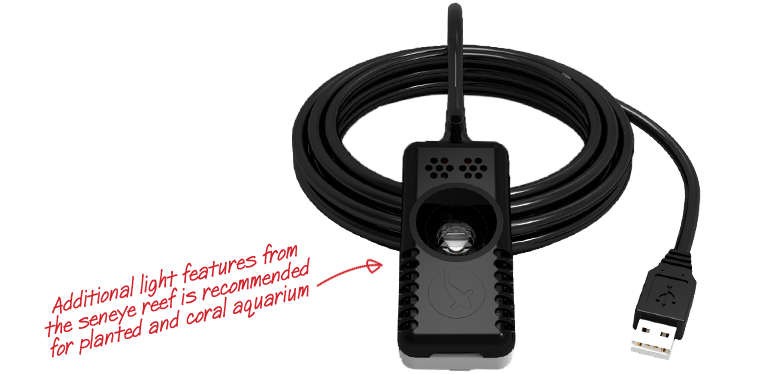
THE LIGHT METER:
This is what gets most people’s attention. It certainly caught my eye after pricing a stand-alone PAR meter. The unit reads PAR, LUX, and KELVIN! The lights are off, which is a great place to start the test. I will place the Seneye directly below my light on the bottom of my frag tank 4 different times of the day. Night, Morning, and Noon. (Always dry your hands before you touch your computer or any electrical device). The lights that will be tested are (morning) 2xActinic BlueT5HO, (day) 2x 10,000K T5HO, and (Noon) 2x15W 6500K CFL bulbs. The tank is 6 inches deep. The bulbs are 12 inches off the water level.
Night Reading: All three meters read zero. That is a relief!
Morning Reading : PAR: 15 LUX: 568 KELVIN: N/A
Day Reading: PAR: 39 LUX: 1448 KELVIN: 10,998
High Noon Reading: PAR: 55 LUX: 22378 KELVIN: 6,079
As far as reading the changes between time frames, this was very helpful to see if my lighting was actually increasing beneficially or not. Seems that it is! As I move the sensor closer to the light it increases the PAR and LUX reading greatly. Without testing alongside an actual light meter I am not positive on accuracy, however the ranges between the readings meant more to me than my guess work that I have been doing. This is an LPS dominant frag tank, so the lower levels are really awesome. If I had gotten a brighter light than I may have burned all my stuff! This is a great reference tool for sure! The unit makes a graph so if your lights ramp up rather than pop on and off you will see the intensity build and drop in a convenient bell curve.
AWESOME FACTORS:
- Three types of light readings
- Periodic Parameter Updates
- Remote access to data
- Small Size
- Great Customer Support
- Affordability
- Very User Friendly
- Accurate Readings
ROOM FOR IMPROVEMENT:
- The quick guide could use a once over to speed up the process. There is not a specific instruction on what or how to soak the slide without looking at the actual manual, even then it is unclear without a tiny bit of research online.
- The suction cup could be replaced with a magnet.
- Soaking the slide was like waiting for Santa Clause.
- The Unit should come with a power supply, even if it raises the cost. Not everyone has a computer in the vicinity of their reef and with all the features, this unit is still affordable. Wireless options are available, so this is not as crucial on a stock device.
- More reef-readings! Calcium and Alkalinity are VERY important and to have a quick reference allows not only daily dose precision, but by the half hour!
WHAT’S THE COST?
Seneye Reef: $169
Seneye+ 3 Month Bundle: $29.95 ($9.99/Month)
Seneye+ 6 Month Bundle: $54.95 ($9.16/Month)
Seneye+ 12 Month Bundle: $104.95 ($8.75/Month)
Active USB Extender: $79.95
USB Extender: $19.95
USB power adapter: $23.95
Float: $27.95
Wireless Options: This varies in cost depending on what you buy. You may already have a device that can work: $0
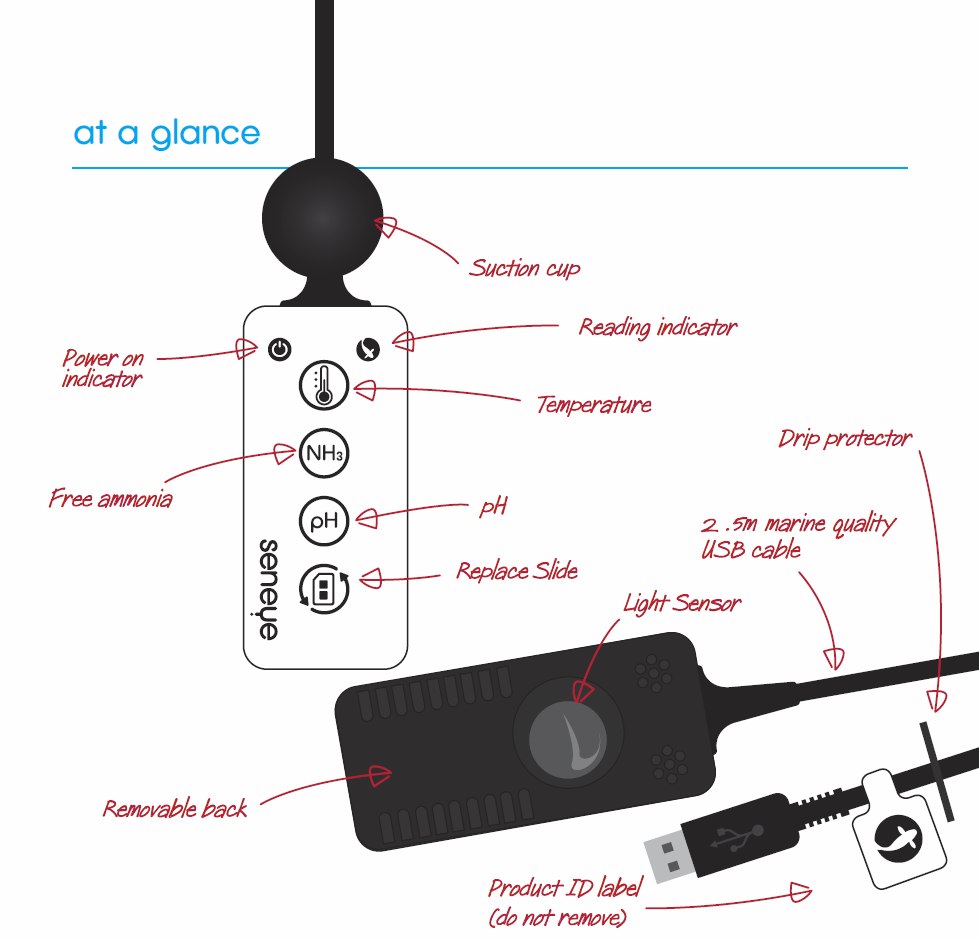
IS IT WORTH IT?
Considering the time it takes to frequently check ammonia level and pH, the cost of a stand-alone light meter, and the convenience of being remotely notified about your tank, this device is well worth the money. The time it takes to get it set up is greatly outweighed by the time I have spent playing with the light meter alone. The added comfort of visually seeing each reading in a graph is by far the coolest part about the device and has already saved me a ton of time. Yeah, it has room for improvement. However, the site and software both hint at future upgrades that could potentially be what we are looking for. Not only does the software, device, and website work very easily but the customer service is fast and they know exactly how to help. I have not had the opportunity to complain about anything.
The fact that you can buy the slides in bulk makes the “monthly rate” drop in price more than you would think. The slides read pH and ammonia, how much do you spend on testing that stuff? Most of us do test for those parameters and many of us monitor pH for many reasons. The other available means are not much cheaper and nearly all of them take time away from staring at your fish though you could also argue that having to monitor from a computer takes up just as much time…but then you would not be on Reef2Reef now would you? Anything that makes something easier has my vote.
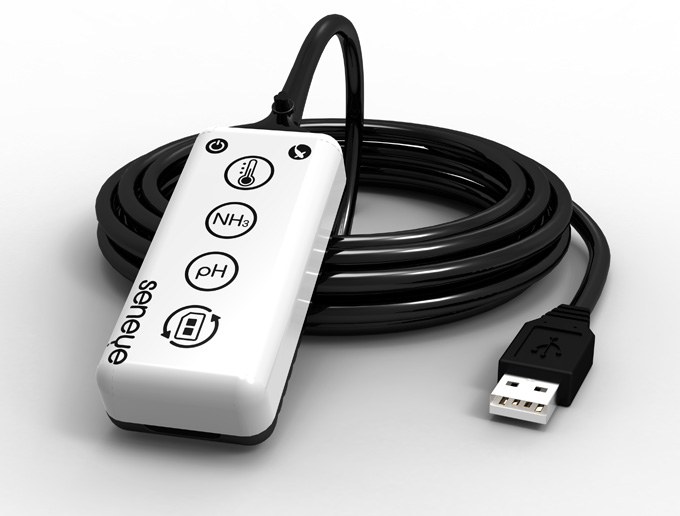
FINAL THOUGHTS
I would certainly recommend this unit and I plan on keeping it as long as I have water to test. The readings are quick, frequently logged, and seemingly accurate. The unit is small, can be placed in your sump, and is very easy to clean. There are only 3 pieces that you have to worry about that are very easy to assemble and the software is very self explanatory. If a PC is not available to be dedicated to this then simply pay for the power supply and plug it in to the computer when you want to upload the readings or go the wireless route. This can be of use to all reefers from maintenance services to hobbyists, even a fish farm will benefit in some way they have not been able to before, at least not as easily. The company is seemingly very open to suggestions, and will do their best to incorporate your needs into their future units. The more reefers that own these, the higher the demand for more features will be. I have a great feeling about the Seneye product line’s future. Such simplicity should not be ignored. If you own an aquarium controller then you still may want to consider one of these for added comfort. With the few issues it has combined with all of its good qualities and accessories, I sincerely give this unit a 9/10. If/when it can display Calcium and Alkalinity readings it will receive an 11/10 and I would buy two more.
For all the latest post and topics from reefers all over the world click here!
For discussion or to comment on this article please click here.
